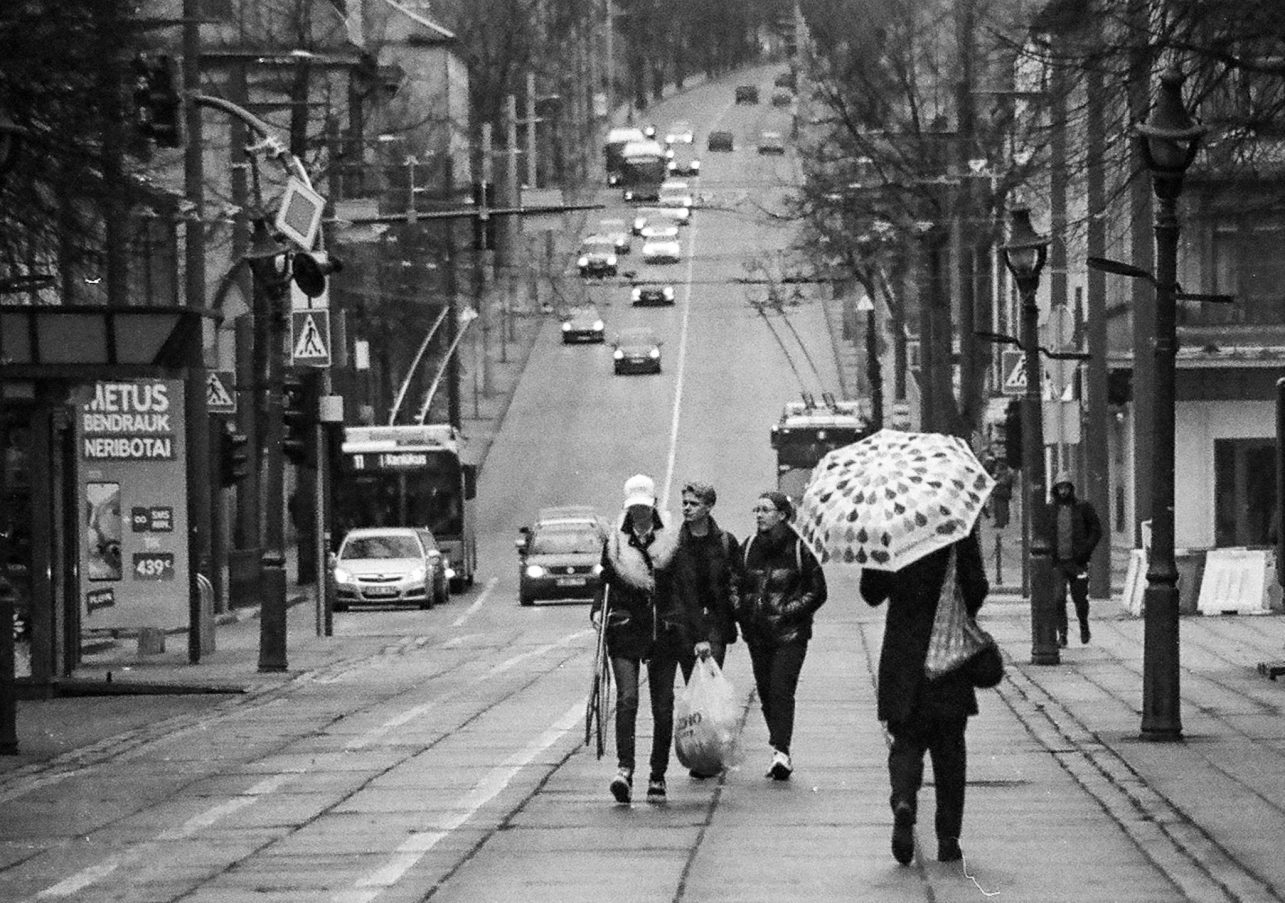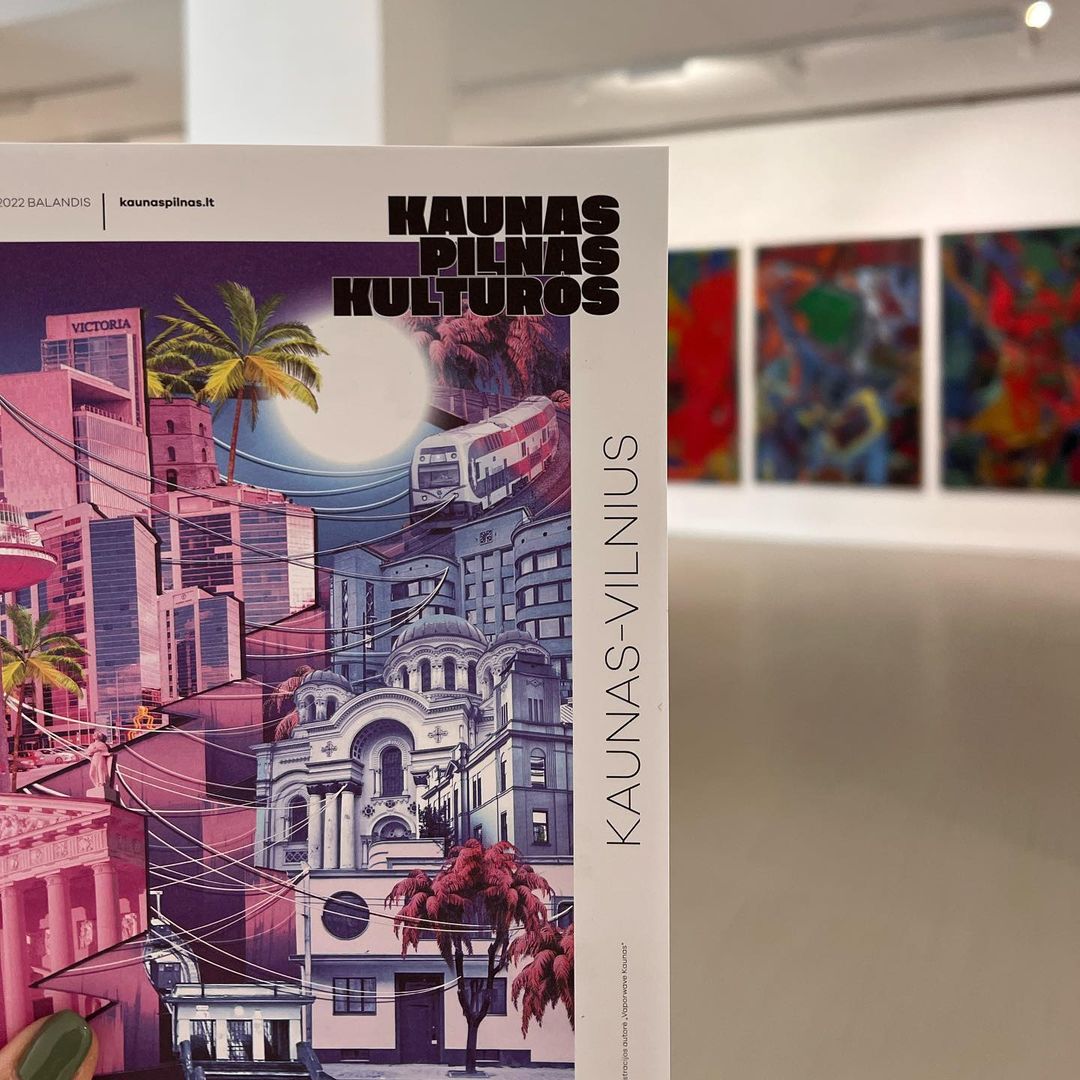There are about 1,500 streets in Kaunas, and therefore street names. Their total length is about 900 kilometers. There are as many as 3600 streets and their names in Vilnius. Of course, there are fewer unique stories hidden under the street name signs. But it would still take more than one book to tell them all.
Historian Mindaugas Balkus, who was recently featured on the pages of Kaunas Full of Culture, wrote one dedicated to V. Putvinskio Street, as well as Kaunas resident Feliksas Zinevičius, who grew up on this street. Vilnius’ crossroads have a wonderful comic book Gatvių susitikimai (street meetings). Since this issue is about the relationship between Vilnius and Kaunas, let’s look at the street names from this angle.

In the old parts of both cities, the principle of giving street names is similar to other Lithuanian (and not only) cities. The most important thing is the road leading to Vilnius (or the nearest big city). The due respect is given to the epoch of the Grand Duchy of Lithuania and there are plenty of hydronyms. As journalist Ugnius Antanavičius – who calculated 70 most popular street names in Lithuania – wrote in 15min, we could say that “The most important historical figure of Lithuania is Vytautas the Great, and the greatest writer of all time is Žemaitė. The favourite Lithuanian plant is linden. Lithuanians love to spend their time in the garden and, of course, builders are the most valued profession.” The latter remark presupposes that with the expansion of cities in the twentieth century, not only personalities but also professions were valued.
Although the reasons for giving a street name in Kaunas and Vilnius are often the same (geography, anniversaries), looking more closely at the already established street names, a network of coincidences, chances, important historical events (or their lack of influence) and even contradictions, begins to grow. Let’s start with Savanorių Avenue. The two avenues.
The beginning of the 7.6 km long Savanorių Avenue in Kaunas dates to 1836, the St. Petersburg – Warsaw post road. Until 1915, this section of a very significant highway, which started in Kaunas Old Town (the post office was on M. Daukšos St. and later on Rotušės Square), was called Peterburgo Street.
Just before the restoration of the Lithuanian state and in keeping with the tradition that the main axis should lead in the direction of the metropolis, the street was called Vilniaus in 1915–1919. In 1919 it was given the name of Ukmergė Highway. Although, it might sound strange (where’s the tradition to travel to the capital?), let’s not forget that it was then that Kaunas became the temporary capital of Lithuania, and Vilnius remained a hard-to-reach city in Poland for two decades.

In 1938, on the 20th anniversary of the Freedom Struggles, this highway was named Savanorių Avenue. This fact dispels the myth we sometimes hear that Savanorių name is a Soviet occupation relic. Quite the opposite. Back then the street was renamed into Raudonosios Armijos (red army) Avenue. The original name was restored in 1989.
Savanorių Avenue was documented during the Kaunas Photo Festival, when Savanorių museum was established in the former Juzė building.
The significance of Savanorių Street in Vilnius, which is 14.6 km long and intersects four parts of Vilnius and is surrounded by shops and manufacturing companies, hasn’t really changed since the mid-19th century. As early as 1840, the road was called the Old Kaunas Post Road (Stary trakt pasztowy z Kowna), and in 1859 it was renamed into Trakai Post Road. In 1890, the street was called Trakai Road. You must be wondering where did Kaunas go? Perhaps people traveled to Kaunas through Ukmergė, after all, during the heyday of the post roads, until the advent of the railway network, this city was an important transport hub.
Trakt pasztowy z Kowna, Droga do Trok, Trokskaja daroga, Generalgubernatorskij Avenue, Proviantskaja, Prowentowa, Trakt Trocki, Legionowa, Savanorių Ave., Tarybinės Armijos, Raudonosios Armijos, Savanorių: this is the development of this street’s names.
Let’s look at Legionowa for a moment. We could say it signals war. Such a renaming was probably the last Polish try to assert their dominance in the context of street naming. The army of independent Lithuania entered the reclaimed Vilnius on October 28, 1939. Already in November, the street was named Savanorių Avenue. This is how Vilnius and Kaunas merged semantically for the first time.
Unfortunately, this phase (the first but not the last) did not last even two years. During the first Soviet occupation, on May 21, 1941, the road became Raudonarmiečių Street. In the summer of 1941, it was given back the name of Savanorių Avenue. However, in the 1950s it was renamed Raudonosios Armijos Alley and later avenue. In 1989, the avenue was given back the Savanorių name once again. The road to Kaunas is straight and smooth again.
From what we have discussed, it is clear that the history of the development of the streets and the change of their names is extremely similar in both cities, even in their stages, that are perhaps only a few months apart. Both avenues have been important since the first half of the 19th century when they were the post roads, and along them, various offices, taverns, repair shops, and guest houses have always been established. Perhaps this is how the current faces of these avenues developed, whose “teeth” (by the way, slowly affected by caries) – the Soviet apartment blocks – turned the roads into avenues. In Vilnius, this part of the avenue is still called Krasnucha (referring to its Red Army name during the Soviet period). In both cities, it is possible to notice the development of apartment buildings. For example, the “ziggurat” in Kaunas. That building will continue to symbolize the ambitious beginning of the 21st century decades after.
Offices, taverns, repair shops, and guest houses still exist today only in modern forms. Obviously, you will never stay hungry while strolling down Savanorių Avenue, you will also find where to stay, shop or even change a tire. Or perhaps you will even rent an office or buy a flat. Thus, it can be concluded that Savanorių Avenue connects Kaunas and Vilnius not only in a geographical and semantic sense but also in terms of its atmosphere and significance in the lives of both cities.
It’s time to talk about the respect the two most important cities have for each other. What does Kauno Street in Vilnius say about the capital’s attitude towards Kaunas and what does Vilniaus Street in the second city say about Kaunas residents? By the way, there are about 100 streets in Lithuania named Kaunas and about 200 named Vilnius. That ratio correlates with the lengths of both Savanorių avenues, right?
Kaunas Street in Vilnius, located in Naujamiestis and a little in the Old Town, was called Kijevskaja until 1940. There are 45 houses on the 1.5 km long street. These are both residential apartment buildings and various business and cultural institutions. Probably the most famous of them is the former Railway Workers’ House of Culture, decorated with a fantastic hook (kablys) made by sculptor Mindaugas Navakas.
The artwork provided the building constructed in 1958 with a new name and, in a sense, dictated its content. Both heavy and electronic music events took place here in the 90s. By the way, it was very convenient for Kaunas residents, since Kablys is only a couple of hundred meters away from the bus and railway stations. After the break, music is playing here again (the new Kablys is celebrating its 10th anniversary this year), skateboarders are riding in it, taste international cuisine there, and much more.
In general, Kaunas Street is full of various food establishments, especially Asian.
Kaunas Street in Vilnius starts rather invisibly from V. Šopeno St. (by the way, not in the honor of the composer, but in the honor of a brewer of the same name) and finishes similarly by flowing into Žemaitė and Naugardukas streets just as imperceptibly. The truth is that if you were to travel further you would indeed reach Kaunas, but this is more of a justification than the premise of why this gray street near the city center – and yet reeking of outskirts – bears the name of Kaunas, the second biggest city that has served as the capital for twenty years.
Vilniaus Street in Kaunas is the axis of the Old Town and one of the representative streets of the city. Present is quite relative here, as the repair works of this artery were still taking place when this text was being written. They were planned for a long time but started unexpectedly for many – especially businesses – last July. There are many galleries, restaurants, stylish boutiques and museums on this street (or in the narrow side streets that intersect Vilniaus Street). Living here is expensive and not always comfortable, given the narrow courtyards, stairwells and everything else, and yet so romantic!
The magnificent Cathedral Basilica of apostles St. Peter and St. Paul of Kaunas is marked with the 1st number of Vilniaus Street. One of the last highlights of the street is the Historical Presidential Palace, that replaced the one in Vilnius for 20 years. So, the name is both solid and historically substantiated. And how was it before?
This axis was formed in the 15th century when Kaunas began to grow, when foreign merchants began to gather in the city, residential houses, various offices and taverns were built. The street was surrounded by large markets. The old names of the street – Ilgoji, Didžioji (long, great) – also refer to its significance. In the 18th century it was already called Didžioji Vilniaus Street. So, the respect is huge.
During the period of Kovno Governorate, Mažoji (small) Vilniaus Street also existed. After the restoration of the state, it was renamed after Klaipėda, but Klaipėda residents began to protest, because the street was a bit like the red-light district. Today, it is called Nemuno Street.
Going back to Vilnius Street in Kaunas, it is worth remembering the word Didžioji, which was lost. In the capital we could compare it to Didžioji Street, which is given a meaning by Vilnius Town Hall, Picture gallery and luxurious hotels. Could Didžioji Street in Vilnius become Kauno Street? Probably not worth it anymore. And Kaunas residents, who want to take a walk on Didžioji Street, can always go to Vaišvydava.

